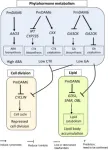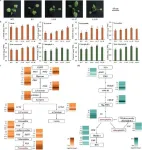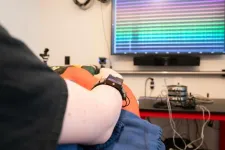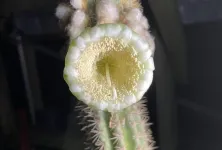(Press-News.org) A string of whale strandings on the East Australian Coastline and questions around the appropriate disposal methods for the remains has prompted a new study that highlights a sustainable, cultural and ecosystem beneficial offshore removal or decomposition.
Dr Olaf Meynecke, from Griffith University’s Whales and Climate Research Program, led the case study, in which a 14m female humpback whale was found floating deceased – likely to due to ship strike – in the coastal waters off Queensland’s Noosa Heads in July 2023.
The remains were intercepted before washing up on the shoreline, then repositioned 30km offshore and fitted with a satellite tag that tracked its position as it drifted with the wind and currents for 6 days before falling to the seabed.
While Dr Meynecke said it was always unfortunate to see these gentle giants deceased, the remains provided a first-ever scientific opportunity to test and develop a prediction method for the whale drift trajectory, allowing the whales’ nutrients to stay in the marine ecosystem and assisted authorities with decision making.
"As we’ve seen more and more whales stranding on Australian beaches in past years, the effective, safe and culturally sensitive removal of whale remains near or on public beaches has become a major issue,” he said.
“Our study shows that forecasting of where whale remains might end up when floating at sea is possible with surprisingly high accuracy.”
There are seven known methods to remove the remains of washed-up whales from our beaches, the most common of all in Australia being to have them transferred to landfill.
Other methods include transporting to a rendering facility for by-products, composting, burials, natural decomposition on the beach, sinking the remains and using explosives to break the remains down – all of which can be costly, technically logistical and can pose public health risks.
Towing whale remains out to deeper waters, as in this pilot study led by Dr Meynecke, has also been used in Australia and internationally previously, but not all these disposal methods were successful due to the remains drifting back to shore or interrupting shipping lanes.
Dr Meynecke said these findings now provided an initial forecasting tool to predict where whale remains would drift, and would offer the additional benefit of retaining the nutrients from decomposition within the marine ecosystem. Scavengers such as tiger sharks also play a crucial role in breaking down whale remains quickly.
“Perished whales provide a substantial nutrient source for marine ecosystems, and strategically placing whale remains offshore can enhance nutrient cycling and foster biodiversity, contribute to carbon removal and marine floor enrichment for up to seven years,” Dr Meynecke said.
“Their gradual decomposition sustains scavengers and detritivores, and support microbial communities and deep-sea organisms.
“The best strategy for handling whale remains depends on multiple factors and should be decided on a case-by-case basis. Offshore disposal can be an ethical, cost-effective, and safe option if managed appropriately.
“By integrating scientific research and practical management strategies presented in our study, we can enhance our ability to predict and effectively manage the drift of whale remains, ensuring that ecological benefits are maximised while minimising adverse impacts.”
The study ‘Dead on the beach? Predicting the drift of whale remains improves management for offshore disposal’ has been published in the Journal of Marine Science and Engineering.
END
Whale remains tracked to highlight sustainable disposal benefits
2024-07-09
ELSE PRESS RELEASES FROM THIS DATE:
Research Spotlight: Researchers find that adverse drug events are frequent and many are preventable in the outpatient setting
2024-07-09
Rachel L. Wasserman, PharmD, of the Department of General Internal Medicine at Brigham and Women’s Hospital, is the lead author and David W. Bates, MD, medical director of Clinical and Quality Analysis for Mass General Brigham and Co-Director of the Center for Artificial Intelligence and BioInformatics for Mass General Brigham, is the senior author of a new study published in BMJ Quality & Safety, “Frequency and preventability of adverse drug events in the outpatient setting.”
How would you summarize your study for a lay audience?
Many studies have analyzed ...
From genomes to gardens: introducing the HortGenome Search Engine for horticultural crops
2024-07-09
The HortGenome Search Engine (HSE) introduces a groundbreaking tool that transforms the exploration of horticultural crops' genetics. Enabling swift access and analysis of data from over 500 plant species, HSE enhances our ability to decode complex genetic networks. This launch marks a pivotal advancement in horticultural studies, offering detailed insights into crop genetics critical for human nutrition and health.
As genomics profoundly reshapes our understanding of horticultural crops, researchers often grapple with dispersed and complex genomic data. This fragmentation significantly hinders effective analysis ...
From winter's rest to spring's bloom: PmDAM6 gene steers plant bud dormancy
2024-07-09
This pivotal study explores the genetic orchestration of bud dormancy in woody perennials, a survival strategy crucial for enduring harsh climates. It focuses on the PmDAM6 gene, revealing its regulatory effects on lipid metabolism and phytohormone dynamics within dormant meristems, which dictate the plant's seasonal transition from rest to growth.
Plant dormancy's genetic mechanisms are vital for enhancing agricultural resilience and productivity. The interaction between lipid metabolism and hormone regulation significantly influences ...
From kale to carotenoid powerhouse: a breakthrough in plant nutrition
2024-07-09
A recent study has identified a crucial regulatory mechanism in Chinese kale, potentially revolutionizing its nutritional profile. By manipulating the BoaBZR1.1 transcription factor, researchers significantly enhanced carotenoid levels, crucial antioxidants for human health. This advancement opens pathways for improving vegetable nutrition through genetic engineering.
Carotenoids, vital antioxidants in plants, are integral for human health, enhancing immunity and preventing diseases. However, many vegetables, including Chinese kale, naturally exhibit low carotenoid levels. To address this nutritional gap, scientists are exploring genetic ...
CMU, Meta announce research collaboration aimed at making computer-based tasks and gaming accessible to people with different motor abilities via wearable sensing technology
2024-07-09
PITTSBURGH - As part of a larger commitment to developing equitable technology, Carnegie Mellon University and Meta announce a collaborative project to make computer-based tasks accessible to more people. This project focuses on using wearable sensing technology to enable people with different motor abilities to perform everyday tasks and enjoy gaming in digital and mixed reality environments.
Meta’s research in electromyography uses sensors placed on the skin to measure the electrical signals the user generates through muscles in their wrist, which are translated into input signals for various devices. While Meta has already ...
Detecting defects in tomorrow’s technology
2024-07-09
Silicon computer chips have served us well for more than half a century. The tiniest features on chips currently sold are approximately 3 nanometers — a startlingly small size given that a human hair is roughly 80,000 nanometers wide. Reducing the size of features on chips will help us meet our endless need for more memory and processing power in the palm of our hand. But the limit of what can be achieved with standard materials and processes is near.
Researchers at the U.S. Department of Energy’s (DOE) Princeton Plasma Physics Laboratory (PPPL) are applying their expertise in ...
It takes a cool microscope and antifreeze to really look at ice
2024-07-09
Ice in nature is surrounded by liquid most of the time, and therefore it is key to understand how ice and liquid interact. A Kobe University and Institute for Molecular Science study could now for the first time directly observe the precise shape of ice at the interface between ice and liquid – by using antifreeze and a refrigerated microscope.
When we slide on ice, when snowflakes form, when we lick ice cream, the surface of the ice is always covered with liquid water, and understanding the interaction between the ...
First local extinction in the US due to sea level rise
2024-07-09
The United States has lost its only stand of the massive Key Largo tree cactus in what researchers believe is the first local extinction of a species caused by sea level rise in the country.
The Key Largo tree cactus (Pilosocereus millspaughii) still grows on a few scattered islands in the Caribbean, including northern Cuba and parts of the Bahamas. In the United States, it was restricted to a single population in the Florida Keys, first discovered in 1992 and monitored intermittently since.
Salt water intrusion from rising seas, soil depletion from hurricanes and high tides, and herbivory by mammals had put significant pressure ...
Empowering Ugandan female youth with self-esteem, self-efficacy, and gratitude using Transcendental Meditation
2024-07-09
A peer-reviewed study published today in Health Care for Women International found that the Transcendental Meditation® (TM®) technique can empower the lives of female youth living under conditions of poverty in the city slums of Kampala, Uganda. Outcomes include increased self-esteem, self-efficacy, and gratitude; and decreased tiredness, worry, and excessive alcohol use. TM helped these young women improve their mental and physical health, as well as their relations with family and community members.
“The ...
Brian Wachtel is promoted to Chief Development Officer at NFCR
2024-07-09
The National Foundation for Cancer Research (NFCR) proudly announces the promotion of Brian Wachtel to Chief Development Officer. Brian will continue his responsibilities as the Executive Director, and his expanded role will further enhance his leadership within the organization.
Brian joined the National Foundation for Cancer Research in September 2016 as the Director of Corporate Partnerships & Special Events. In that capacity, he was in charge of organizing and expanding NFCR’s community outreach events. One of his important ...








